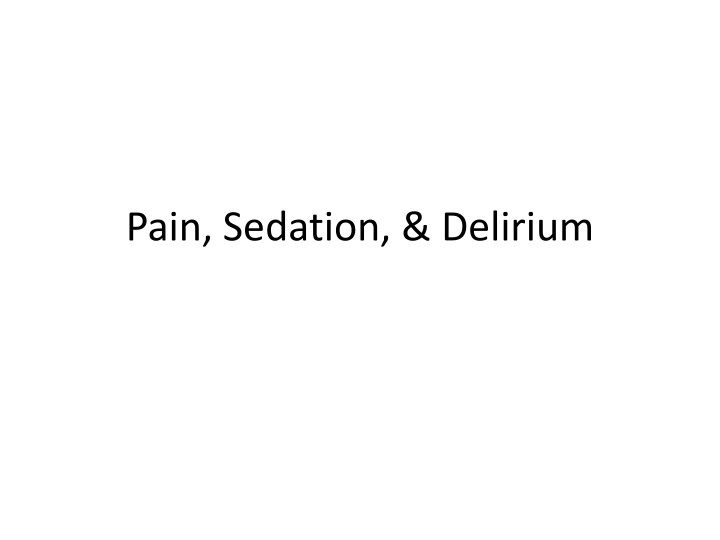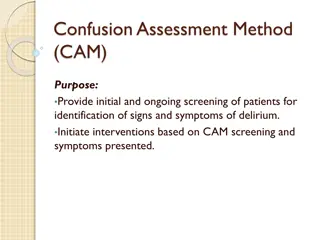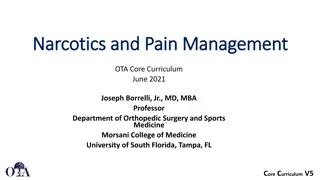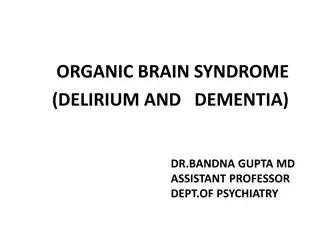Pain, Sedation, & Delirium Management in Critical Care
Effective management of pain, sedation, and delirium is essential in critical care settings to optimize patient comfort, facilitate recovery, and ensure better outcomes. The goal is to control pain adequately, minimize sedative use, and address indications for analgesia and sedatives while being mindful of the potential adverse effects. General principles include treating pain first, avoiding benzodiazepines if possible, and targeting sedation goals through daily assessment and interventions. Various medications such as fentanyl, morphine, and hydromorphone are commonly used for pain management, each with their own dosing, pharmacokinetics, and adverse effects.
Download Presentation

Please find below an Image/Link to download the presentation.
The content on the website is provided AS IS for your information and personal use only. It may not be sold, licensed, or shared on other websites without obtaining consent from the author.If you encounter any issues during the download, it is possible that the publisher has removed the file from their server.
You are allowed to download the files provided on this website for personal or commercial use, subject to the condition that they are used lawfully. All files are the property of their respective owners.
The content on the website is provided AS IS for your information and personal use only. It may not be sold, licensed, or shared on other websites without obtaining consent from the author.
E N D
Presentation Transcript
Pain & Sedation - Goal Pain Management Control pain adequately enough with the the patient making that final determination Ideally achieve a maximally functional patient Control does not necessarily mean zero pain Sedative Management To relieve anxiety with the minimal amount of sedative/hypnotics administered Patients should be calm, lucid, pain-free, interactive and cooperative with care
Analgesia - Indications Patient reports pain Decrease air hunger associated with certain modes of mechanical ventilation Neuromuscular Blockade Post-surgical Trauma States which increase metabolic demand Chronic use of narcotics
Sedatives - Indications Anxiety not thought to be delirium Ventilator dyssynchrony Neuromuscular Blocking Agents (aka paralysis) Safety of patient at risk Intracranial HTN Refractory status epilepticus Severe respiratory failure
Adverse Effects Analgesia Respiratory depression Constipation Withdrawal Itching Nausea Sedatives Delirium Hypotension Active metabolites Withdrawal Prolonged ICU stay and MV days Others depending on agent used
General Principles Think PRNs first Treat the pain first Stay away from benzodiazepines if you can Daily assessment of need Daily holiday (aka Daily Sedation Interruption) Target a sedation goal by using an easy to follow scale (RASS or Ramsey)
Pain Meds - IV Agent Typical Dose Pharmacokinetics Adverse Effects Fentanyl Load: 25 - 50 g Maintenance: 25- 100 g/hr Onset: seconds Half-life: 1.5 6 hrs Metabolism: Liver VD: Fat soluble No active metabolites Skeletal muscle rigidity Morphine Load: 2 - 5 mg Maintenance: 1 - 5 mg/hr Onset: 5 10 min Half-life: 3 7 hrs Metabolism: Liver VD: Water soluble Excretion: Renal Histamine release leads to hypotension and itch Hydromorphone Load: 0.4 2 mg Onset: 5 min Half-life: 1 4 hrs Metabolism: Liver VD: Water Excretion: Renal Standard narcotic Safer in organ dysfunction than morphine Maintenance: 0.5 2 mg/hr
Sedation Meds- IV Agent Typical Dose Pharmacokinetics Adverse Effects Propofol Load: none Maintenance: 0 100 g/kg/min Onset: 1 min Half-life: 2-4 min* Metabolism: Liver Hypotension Respiratory depression Hypertriglyceridemia Pancreatitis PRIS Dexmedetomidine Load: none Maintenance: 0.2 1.5 g/kg/hr Onset: 5 10 min Half-life: 1 2 hrs Metabolism: Liver No active metabolites Hemodynamic Withdrawal if longer than 7 days Cannot use for NMBA Midazolam Load: 1 2 mg Maintenance: 1 4 mg/hr Onset: 2 3 min Half-life: 2 4 hrs Metabolism: Liver Active Metabolites Excretion: Renal Respiratory depression Hypotension if rapid infusion Nausea/Vomiting Delirium
Weaning & DSI Daily Assessments Daily Sedation Interruptions Targeted Sedation with RASS All have been shown to decrease MV days and ICU LOS May also affect long term cognition
Neuromuscular Blocking Agents (NMBA) Main indication severe ARDS/hypoxemia & severe dyssynchrony not controlled by sedation Deep Sedation (RASS -5) required Vecuronium Load: 0.1 mg/kg Infuse: 0 10 mg/hr Duration: 45 min Metabolized: Kidney & Liver Cost: $ Cisatracurium Load: 0.2 mg/kg Infuse: 0.5 10 mcg/kg/min Duration: 45 60 min Metabolized: Hoffmann Cost: $$$ Might be better in severe ARDS
Delirium Sudden, fluctuating changes in consciousness and cognition that develops over a short period of time Hypoactive or Hyperactive
Delirium Increased Hospital LOS Increased Cost to deliver care Increased Mortality 3-fold in MV pt Data suggest association with long-term brain dysfunction (i.e. dementia, SNF placement)
Delirium Non-Modifiable Age Genetics Baseline Dementia Substance Abuse Hypertension Modifiable Critical Illness Pain level Acute Renal Failure Anxiety Extra Tubes and Drips Medications Environmental factors Weakness
Non-Pharmacologic Management Reverse underlying cause Assess nutritional status Re-orientation Talk to patient as if not delirious Correct sensory deficits Limit extraneous stimuli in environment Sitters
Pharmacologic Management Neuroleptics Haloperidal Quetiapine Risperidone Benzodiazepines if you suspect withdrawal Vitamins Thiamine Cyanocobalamin
True or False Intubated patients on mechanical ventilation need to be sedated. A. True. The ET tube is very uncomfortable and provokes anxiety. B. True. Allowing patients to remember the trauma of being in the ICU is inhumane. C. False. ICU patients never experience anxiety. D. Depends. The patient s condition will determine the need for sedation.
True or False In the ICU, continuous infusions of pain and sedation medications are preferred. A. True. Patients sleep better that way. B. True. Better to use a drip because PRNs are too hard to keep up with. C. True. The RNs always want them, so it s just easier to do what they want. D. False. PRNs are better for the patient because there is less risk of over-sedation.
Awakening Trials Kress JP, et. al. 2000 NEJM Randomized Control Trial, n = 128 Daily Sedation Interruption (DSI) Protocol Protocol conducted by study RN and MD
KaplanMeier Analysis of the Duration of Mechanical Ventilation Kress JP et al. N Engl J Med 2000;342:1471-1477.
KaplanMeier Analysis of the Length of Stay in the Intensive Care Unit (ICU) Kress JP et al. N Engl J Med 2000;342:1471-1477.























